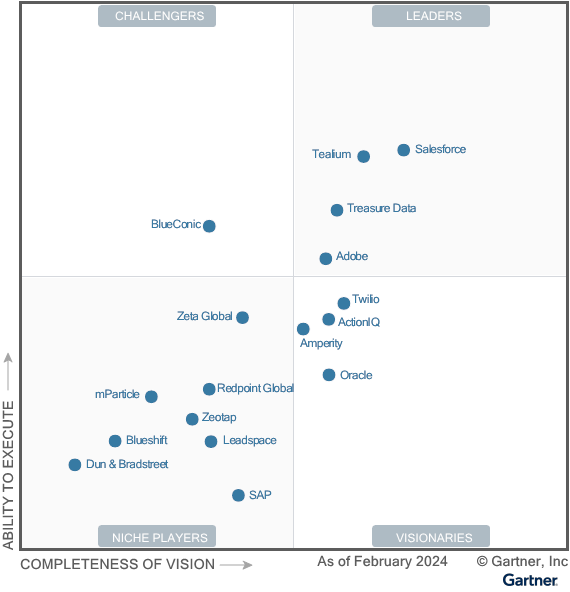Buying a Customer Data Platform (CDP) is one of the most important, and one of the most confusing decisions your data and marketing teams can make. The right CDP is an essential tool to coalesce first-party customer data, create targeted audiences and segments, and enable you to activate that data across the multiple touchpoints involved in the complex buyer’s journey. Understanding what features and functions each CDP software actually supports, though, is as easy to confirm as trying to assemble IKEA furniture without instructions while blindfolded and using only your toes.
Solvenna resources strive to stay up to date on the latest trends, offerings, misconceptions, software vendors and more in the CDP space. Gartner recently threw their hat in the CDP ring too with their first-ever CDP magic quadrant. Thank you, Gartner. We are hoping this is the first step in putting some structure in place for who and what can call themselves a CDP. To date, many of the vendors claiming to offer a CDP have actually just re-branded themselves to latch onto the marketing buzzword in hopes of selling more of their “old category” solution. Some of the vendors only do a fraction of what a CDP is truly meant to do. This “I can do that too” approach might be changing now with the release of the Gartner Magic Quadrant for Customer Data Platforms.

Gartner’s rating is a start. There are certainly additional, viable vendors that are not on this list and the inclusion of some of these vendors could be challenged as well. Putting structure to this category will be very difficult and will take time.
Many of the companies that claim to offer a CDP have originated from very different places and thus have different capabilities. The key to demystifying the CDP space is to look at the origin of each CDP vendor. What type of solution did they start with or purchase to get in the CDP game? What problem was that tech solving? Let’s take a quick look at the most common types of CDP’s …
Tag Management Systems (TMS)
Tag management was a category that flourished in the late 2000s. It was created to solve the problem of every website having many “tags” (JavaScript code snippets on websites) that capture customer data and send it to ad networks like DoubleClick (now Google) or analytics vendors like Omniture (now Adobe Analytics). Tag Management turned out to be more of a feature than a category, and thus these early vendors repositioned as CDPs trying to play a bigger game with mixed success. For the right use cases (e.g., web data capture and routing in real time) CDIs can be a good fit, but for many others they are inadequate given their historical shortcomings.
Data Integration Centric
Data Integration CDPs are like a second cousin to the Master Data Management (MDM) category. Depending on the vendor, they can usually be used for enterprise batch or real-time integrations, and they can solve complex Customer mastering challenges (deterministic and probabilistic matching). This category typically has comparatively strong data management capabilities. However, when it comes to business self-service, easy to use audience definition, segmentation, customer journeys and reporting the results vary. Because of their data integration origin, many of these require data to be copied, integrated, transformed, and stored into a separate database rather than accessing the data where it already resides. There are pros and cons to all of this.
Composable First
The term composable is as confusing and misused as that of CDP. Buyer beware. Some of these are great solutions. Some are not. You simply must know what use cases or business problems you are trying to solve and how this “composable” choice will actually fit in with other technologies you already own or need to buy. The word composable is as catchy as “streaming service”. How many of us really enjoy having to subscribe to 10 different streaming services to watch the same set of shows we used to watch through our single cable provider? Again, there are pros and cons to both approaches.
Marketing Automation Transition
Several companies claiming to be a CDP actually started off as traditional Marketing Automation Platforms (MAPs). These companies recognized the value and expanded market opportunity to position themselves as CDPs rather than MAPs. However, since these platforms originally focused on marketing automation, some core capabilities might not be as robust or tailored to specific data management needs as those of dedicated CDP vendors. Specific areas requiring attention include identity management and data transformation (the “T” in ETL). While these vendors typically excel in usability for less technical users around segmentation and targeting, it comes with the trade-off that another technology in the architecture is usually needed to handle proper data preparation. Nonetheless, this strategic move allows them to cater to the increasing demand for holistic customer data management while capitalizing on their established market presence and trust among users.
Are you aware of what to watch out for?
There is no single recommendation. You really need to evaluate your architecture, existing tech stack, requirements, needs and the skills of your resources to pick the right one for you. Do you want a CDP decoder ring? Reach out to Solvenna and we’ll be happy to share our thoughts on pros, cons, pitfalls, lessons learned, and more.




